My most current blog entry:
Entries in Aberdeenshire, Scotland (39)
Scotland Coastal Villages - Banff and MacDuff
 Tuesday, June 21, 2016 at 4:21AM
Tuesday, June 21, 2016 at 4:21AM  Here I am again . . . tagging along with my wife on her golf tournament. I dropped her off at Duff House Royal Golf Club and set off for a little photographic expedition to the coastal villeges nearby: Banff and MacDuff. This is the village center of Banff.
Here I am again . . . tagging along with my wife on her golf tournament. I dropped her off at Duff House Royal Golf Club and set off for a little photographic expedition to the coastal villeges nearby: Banff and MacDuff. This is the village center of Banff.
 Banff is a very old village. It had its first castle in 1163, build to repel the invading Vikings.
Banff is a very old village. It had its first castle in 1163, build to repel the invading Vikings.
 Banff is a more prosperous village. It was a trading center until the 1770s, when a port was constructed.
Banff is a more prosperous village. It was a trading center until the 1770s, when a port was constructed.
 Banff is built up the side of a rather steel hill that rises up from a broad bay. There are still narrow walking paths that give the only access to quaint cottages.
Banff is built up the side of a rather steel hill that rises up from a broad bay. There are still narrow walking paths that give the only access to quaint cottages.
 A typical 17th century house in Banff.
A typical 17th century house in Banff.
 Banff is a lovely village. It is just big enough to offer all the amenities, but small enough to still feel like a village. I could see living in this house (it's for sale) on street off the bay.
Banff is a lovely village. It is just big enough to offer all the amenities, but small enough to still feel like a village. I could see living in this house (it's for sale) on street off the bay.
 There are a couple of scaled-down 'supermarkets' in Banff, but the downtown is still vibrant, owing to the fact that the nearest mall is 50 miles away.
There are a couple of scaled-down 'supermarkets' in Banff, but the downtown is still vibrant, owing to the fact that the nearest mall is 50 miles away.
 There are several quaint old hotels in town.
There are several quaint old hotels in town.
 I couldn't resist snooping around the fascinating old cemetery . . . right in the middle of the village.
I couldn't resist snooping around the fascinating old cemetery . . . right in the middle of the village.
 I come from a very wet place (Western Oregon in the USA), so I understand this kind of moss.
I come from a very wet place (Western Oregon in the USA), so I understand this kind of moss.
 There were several extraordinary crypts and carved grave covers.
There were several extraordinary crypts and carved grave covers.
 Just so your survivors wouldn't have to wonder what happened to you . . . you put a skull and bones on your grave marker. [Note to self: do not have horizontal grave stone in rainy environment.]
Just so your survivors wouldn't have to wonder what happened to you . . . you put a skull and bones on your grave marker. [Note to self: do not have horizontal grave stone in rainy environment.]
 I decided to walk back through old town Banff toward the sea and the jetty. These are the oldest continuously inhabited buildings in Banff, dating from the mid-14th century.
I decided to walk back through old town Banff toward the sea and the jetty. These are the oldest continuously inhabited buildings in Banff, dating from the mid-14th century.
 Being such a very old village, there were, of course, a few buildings that were in full deterioration. My favorite photo subject!
Being such a very old village, there were, of course, a few buildings that were in full deterioration. My favorite photo subject!
 House number 30.
House number 30.
 I love the story of time and weather written on these old, unattended, doors.
I love the story of time and weather written on these old, unattended, doors.
 House number 32. Nobody home.
House number 32. Nobody home.
 The sea wall at high tide. I followed the wall out to the jetty next to a raging North Sea.
The sea wall at high tide. I followed the wall out to the jetty next to a raging North Sea.
 Crabbing and shrimping pots lined the old stone jetty.
Crabbing and shrimping pots lined the old stone jetty.
 I studied these for a few minutes, imagining myself as a crab, but I couldn't work out how these thing worked.
I studied these for a few minutes, imagining myself as a crab, but I couldn't work out how these thing worked.
 View from the jetty: A broad bay separates Banff from the even smaller village of MacDuff, seen on the horizon. This is where the River Deveron estuary ends in the North Sea.
View from the jetty: A broad bay separates Banff from the even smaller village of MacDuff, seen on the horizon. This is where the River Deveron estuary ends in the North Sea.
 Ther is a small light at the end of the jetty. At high tide the waves occasionally break over sea wall.
Ther is a small light at the end of the jetty. At high tide the waves occasionally break over sea wall.
 I was getting hungry, so I took a different street back to my car. I passed this relic of days gone bye.
I was getting hungry, so I took a different street back to my car. I passed this relic of days gone bye.
 I often ask myself, what is it about old doors that compel me to take a photograph? Something about mortality, I believe.
I often ask myself, what is it about old doors that compel me to take a photograph? Something about mortality, I believe.
 I made my way back to the village center and then on up the steep hill to a nice cafe and had a bowl of Cullen Skink, a scone, and a cup of coffee.
I made my way back to the village center and then on up the steep hill to a nice cafe and had a bowl of Cullen Skink, a scone, and a cup of coffee.
 After lunch I decided to find the castle whose sign I saw driving in. My GPS said there was a castle only four miles away. I ended up on this gravel road through a beautiful wood.
After lunch I decided to find the castle whose sign I saw driving in. My GPS said there was a castle only four miles away. I ended up on this gravel road through a beautiful wood.
 I knew I was getting close to a castle when I started to see the old outbuildings.
I knew I was getting close to a castle when I started to see the old outbuildings.
 I love these old abandoned stone houses. I have a fantasy each time of fixing it up and living in it.
I love these old abandoned stone houses. I have a fantasy each time of fixing it up and living in it.
 Now I knew I was getting close . . . a castle gate house . . . and occupied too.
Now I knew I was getting close . . . a castle gate house . . . and occupied too.
 AH! There it is. A castle through the trees. I was not sure if this particular castle was occupied by the laird, or was open to the public. I was a little concerned someone would run our and yell at me that I was trespassing.
AH! There it is. A castle through the trees. I was not sure if this particular castle was occupied by the laird, or was open to the public. I was a little concerned someone would run our and yell at me that I was trespassing.
 I stayed back in the trees, just in case . . .
I stayed back in the trees, just in case . . .
 Magnificent and stately Craigston Castle, built in 1604. As it turns out, you can stay in this castle as a "luxury self-catering vacation home." No kidding. You can make a booking here.
Magnificent and stately Craigston Castle, built in 1604. As it turns out, you can stay in this castle as a "luxury self-catering vacation home." No kidding. You can make a booking here.
 I left the castle for a short drive to the harbour village of MacDuff. We stayed in this village right after we moved to Scotland. In fact, it was the first over night stay we made.
I left the castle for a short drive to the harbour village of MacDuff. We stayed in this village right after we moved to Scotland. In fact, it was the first over night stay we made.
 MacDuff has a proper shipyard for refitting fishing boats.
MacDuff has a proper shipyard for refitting fishing boats.
 Shipyards are visually intereting places. What in the world are these sharpened steel 'blades' used for? I have no idea.
Shipyards are visually intereting places. What in the world are these sharpened steel 'blades' used for? I have no idea.
 The rust was thick, but the pattern and color was captivating.
The rust was thick, but the pattern and color was captivating.
 Nice clean and newly painted fishing boats. I got lucky as the sun finally came out in the afternoon.
Nice clean and newly painted fishing boats. I got lucky as the sun finally came out in the afternoon.
 I could have stayed all day in the MacDuff shipyards, but my wife called to say her round was over. Great idea to affix these benches inside the seawall.
I could have stayed all day in the MacDuff shipyards, but my wife called to say her round was over. Great idea to affix these benches inside the seawall.
 We drove on the A947 back to Aberdeen. We passed a sign for Fyvie Castle . . . and I couldn't resist going in. My wife hadn't been before.
We drove on the A947 back to Aberdeen. We passed a sign for Fyvie Castle . . . and I couldn't resist going in. My wife hadn't been before.
 Fyvie castle is a proper castle. Built in 1211, Fyvie was the site of an open-air court held by Robert the Bruce, and Charles I lived there as a child.
Fyvie castle is a proper castle. Built in 1211, Fyvie was the site of an open-air court held by Robert the Bruce, and Charles I lived there as a child.
 Fyvie Castle was closed, but the vast grounds and gardens were opened. I will post more from the fabulous gardens soon.
Fyvie Castle was closed, but the vast grounds and gardens were opened. I will post more from the fabulous gardens soon.
Scotland - The First Nice Day of Spring
 Sunday, May 29, 2016 at 4:05PM
Sunday, May 29, 2016 at 4:05PM  Looking out the back window at our garden one day in late April, I happen to notice the flowering bushes were flowering. I also noticed it was a nice day . . . the first nice day of Spring.
Looking out the back window at our garden one day in late April, I happen to notice the flowering bushes were flowering. I also noticed it was a nice day . . . the first nice day of Spring.
 So, I grabbed my trusty Fuji X-T1 camera and headed outside. Yummie light and color.
So, I grabbed my trusty Fuji X-T1 camera and headed outside. Yummie light and color.
 Such happy blooms . . . after such a long, cold, and dark winter in Aberdeen.
Such happy blooms . . . after such a long, cold, and dark winter in Aberdeen.
 There was so much new growth to notice, and capture, around the house.
There was so much new growth to notice, and capture, around the house.
 Buds and new growth.
Buds and new growth.
 I love the colors of rose bush newly sprouting leaves.
I love the colors of rose bush newly sprouting leaves.
 The daffodils had just popped in the yard . . . and all over town too. Aberdeen is famous for its billions of daffodils. It was just too nice outside to spend the day inside . . . .
The daffodils had just popped in the yard . . . and all over town too. Aberdeen is famous for its billions of daffodils. It was just too nice outside to spend the day inside . . . .
 . . . so I stuck my head inside and yelled up the stairs, "Honey, we're going for a walk today!" "Great," came the reply. Our choice was to walk the nature trails around Crathes Castle, 20 minutes for our home. We parked near the castle gate house and headed up the trail (yellow).
. . . so I stuck my head inside and yelled up the stairs, "Honey, we're going for a walk today!" "Great," came the reply. Our choice was to walk the nature trails around Crathes Castle, 20 minutes for our home. We parked near the castle gate house and headed up the trail (yellow).
 The trees were still bare of any foliage.
The trees were still bare of any foliage.
 Although it was April 24th, Spring comes very late at these far northern latitudes (57.1526°N 2.1100°W).
Although it was April 24th, Spring comes very late at these far northern latitudes (57.1526°N 2.1100°W).
 The beauty of the day reflected in an abandoned stone pit.
The beauty of the day reflected in an abandoned stone pit.
 There were wisps of budding leaves on some species . . . signs of the beauty to come.
There were wisps of budding leaves on some species . . . signs of the beauty to come.
 We headed deeper into the castle grounds, and the Scottish pine forest.
We headed deeper into the castle grounds, and the Scottish pine forest.
 The pine cones had a wonderful in the heat of the first Spring warmth.
The pine cones had a wonderful in the heat of the first Spring warmth.
 In fact, the whole forest smelled of freshness and the prospect of Spring.
In fact, the whole forest smelled of freshness and the prospect of Spring.
 The trail followed a burn through some lovely scenery and quaint arrangements.
The trail followed a burn through some lovely scenery and quaint arrangements.
 Boughs reflected in the pond.
Boughs reflected in the pond.
 "Crathes sits on land given as a gift to the Burnett of Leys family by King Robert the Bruce in 1323." As such, a castle of this period had to supply and manufacture everything for its own needs. This is the Crathes Castle Mill Pond.
"Crathes sits on land given as a gift to the Burnett of Leys family by King Robert the Bruce in 1323." As such, a castle of this period had to supply and manufacture everything for its own needs. This is the Crathes Castle Mill Pond.
 The National Trust For Scotland has done an excellent job of marking the trails and, where necessary, protecting any fragile land.
The National Trust For Scotland has done an excellent job of marking the trails and, where necessary, protecting any fragile land.
 The elevated walkway followed a delightful stream.
The elevated walkway followed a delightful stream.
 The peaceful, slow movement of an amber stream passing through the naked forest . . .
The peaceful, slow movement of an amber stream passing through the naked forest . . .
 It was fun walking along these elevated paths through the early Spring of a Scottish forest.
It was fun walking along these elevated paths through the early Spring of a Scottish forest.
 We took a lot of iPhotos of ourselves at every opportunity . . . and there were many.
We took a lot of iPhotos of ourselves at every opportunity . . . and there were many.
 The wide path eventually opened up into some open fields. We passed 10-15 other walkers on the day, but could see the popularity of these woods for walking by the size of the paths. Crathes Castle is on the "Castle Trail" for tourists, and is packed in the summer.
The wide path eventually opened up into some open fields. We passed 10-15 other walkers on the day, but could see the popularity of these woods for walking by the size of the paths. Crathes Castle is on the "Castle Trail" for tourists, and is packed in the summer.
 Under a bright Spring sky.
Under a bright Spring sky.
 From the meadow back into the trees. The castle grounds offer a wonderful array of beautiful natural scenes.
From the meadow back into the trees. The castle grounds offer a wonderful array of beautiful natural scenes.
 This Victorian gate post reminded me of the political and economic power the lairds had in old Scotland. If you were to come across this gate post in a forest, you would steer clear of the castle. The gate post was a symbol of the power of whom lived within.
This Victorian gate post reminded me of the political and economic power the lairds had in old Scotland. If you were to come across this gate post in a forest, you would steer clear of the castle. The gate post was a symbol of the power of whom lived within.
Scotland - Drum Castle and Gardens
 Sunday, May 22, 2016 at 4:23AM
Sunday, May 22, 2016 at 4:23AM A nice day in northeast Scotland . . .
 The grounds and permission to build Drum Castle was granted in 1325. It is the ancestral home of Clan Irvine. It is about 15 minutes from our home in Aberdeen.
The grounds and permission to build Drum Castle was granted in 1325. It is the ancestral home of Clan Irvine. It is about 15 minutes from our home in Aberdeen.
 Drum Castle is a part of the Scottish National Trust properties. It sees a fair number of tourists during the summer months, but today there were only a few people wandering about.
Drum Castle is a part of the Scottish National Trust properties. It sees a fair number of tourists during the summer months, but today there were only a few people wandering about.
 Yes, Scottish castles are wonderful, but many of them still maintain their gardens and grounds in spectacular fashion.
Yes, Scottish castles are wonderful, but many of them still maintain their gardens and grounds in spectacular fashion.
 Plant species from around the world were often brought back to the family estate by adventurous colonialists during and before the Victorian era.
Plant species from around the world were often brought back to the family estate by adventurous colonialists during and before the Victorian era.
 There are always so many fascinating flowers to look at in the gardens and grounds.
There are always so many fascinating flowers to look at in the gardens and grounds.
 The walk to the formal, walled gardens took us past a delightful nature pond.
The walk to the formal, walled gardens took us past a delightful nature pond.
 Although it is May 21st, Spring has not fully arrived here in these far northern latitudes. I was hoping for more flowering . . . .
Although it is May 21st, Spring has not fully arrived here in these far northern latitudes. I was hoping for more flowering . . . .
 The walls that surrounded the gardens were covered with magnificent espalier.
The walls that surrounded the gardens were covered with magnificent espalier.
 Climbing vines on the interior, shady side, of the castle garden were only just beginning to show signs of budding . . . in LATE MAY!
Climbing vines on the interior, shady side, of the castle garden were only just beginning to show signs of budding . . . in LATE MAY!
 The gardens themselves were lovely, hedge-lined masterpieces of architecture.
The gardens themselves were lovely, hedge-lined masterpieces of architecture.
 There are many such lovely scenes through the gardens. As you might imagine, there are weddings, and wedding photography taking place here almost every day.
There are many such lovely scenes through the gardens. As you might imagine, there are weddings, and wedding photography taking place here almost every day.
 So inviting on a sunny day . . .
So inviting on a sunny day . . .
 In late summer these arches are covered in fragrant honeysuckle vine . . . perfect for a bride and groom!
In late summer these arches are covered in fragrant honeysuckle vine . . . perfect for a bride and groom!
 The beds are still being planted (and transplanted).
The beds are still being planted (and transplanted).
 The plantings await some sunny days to bring out their full beauty.
The plantings await some sunny days to bring out their full beauty.
 There were still a couple of cabana tents left here and there: evidence of recent weddings. Ever-changing lighting conditions made the photography challenging.
There were still a couple of cabana tents left here and there: evidence of recent weddings. Ever-changing lighting conditions made the photography challenging.
 There were some novel tulips still in bloom.
There were some novel tulips still in bloom.
 A purple flowing espalier. Beautiful.
A purple flowing espalier. Beautiful.
 We walked out past the castle and wondered at its magnificence.
We walked out past the castle and wondered at its magnificence.
 Drum Castle.
Drum Castle.
 The road that leads out of Drum Castle passes through a wonderful wood in early foliage.
The road that leads out of Drum Castle passes through a wonderful wood in early foliage.
 I wanted to say in this forest for the rest of the day . . .
I wanted to say in this forest for the rest of the day . . .
 Instead we went home . . . . somehow my back garden does not seem so impressive to me anymore!
Instead we went home . . . . somehow my back garden does not seem so impressive to me anymore!
Scotland - Fraserburgh
 Sunday, May 15, 2016 at 5:20AM
Sunday, May 15, 2016 at 5:20AM It's nice when my wife has a golf tournament out of town . . . I get to drive here there and then explore the area around Fraserburgh.
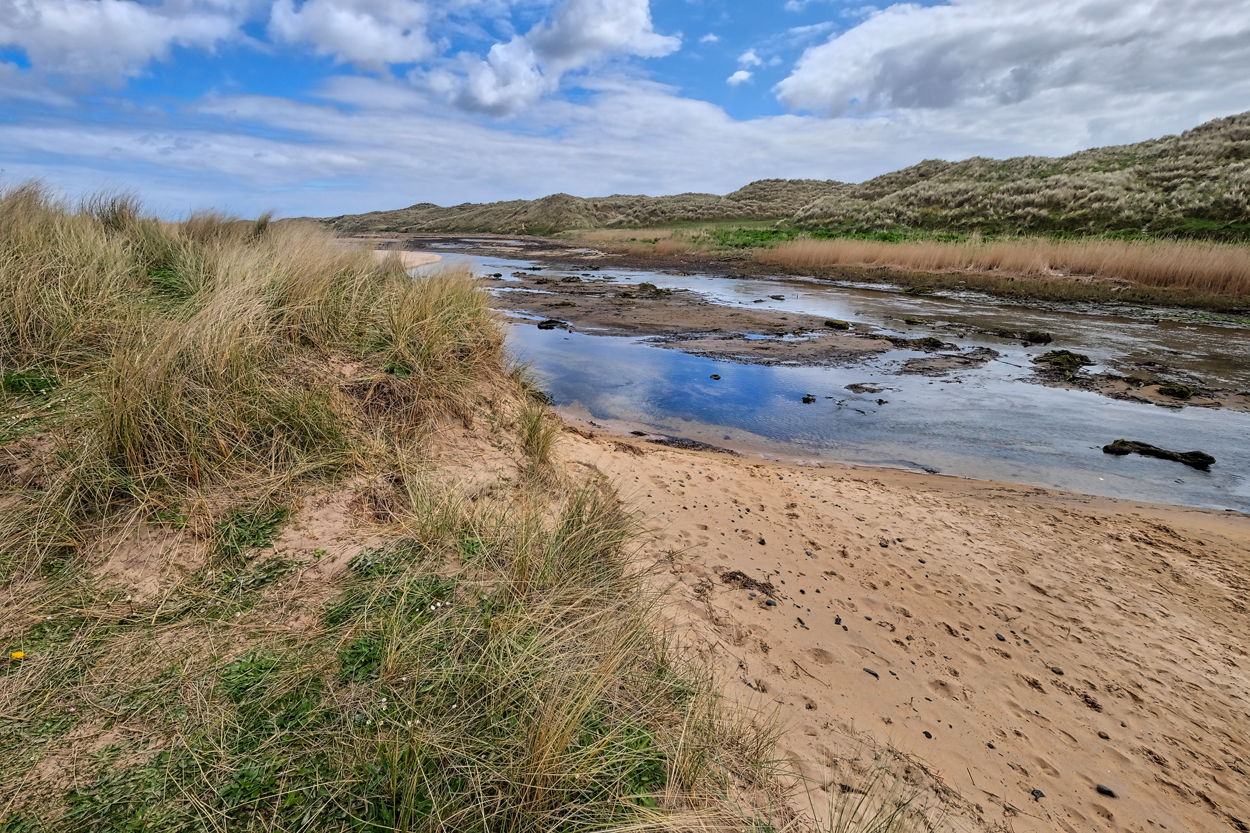 The Waters of Philorth.
The Waters of Philorth.
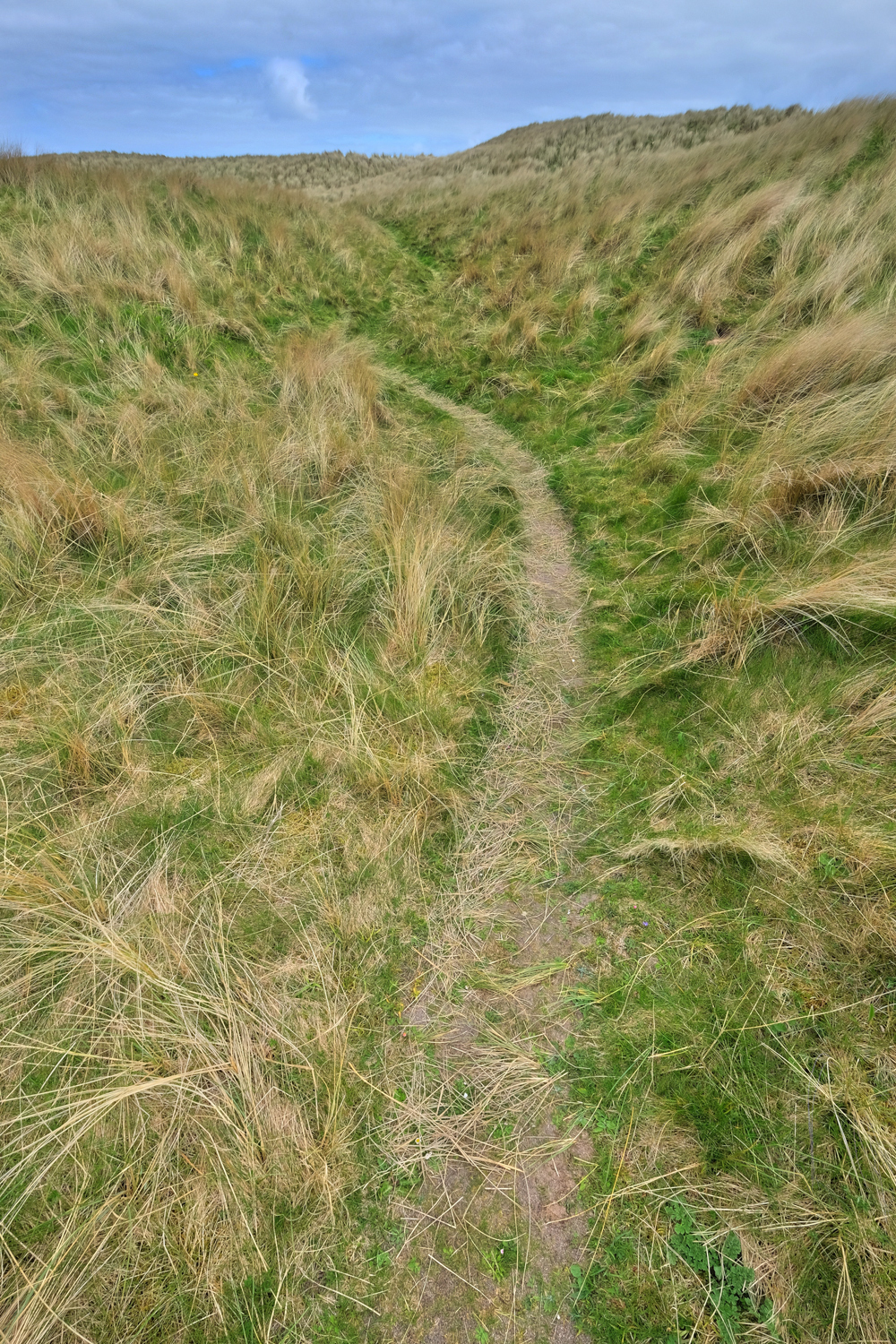 Fraserburgh Golf Club is the 7th oldest golf course in the world, having been founded in 1777. It sits among the dunes on the Scottish Aberdeenshire Coast.
Fraserburgh Golf Club is the 7th oldest golf course in the world, having been founded in 1777. It sits among the dunes on the Scottish Aberdeenshire Coast.
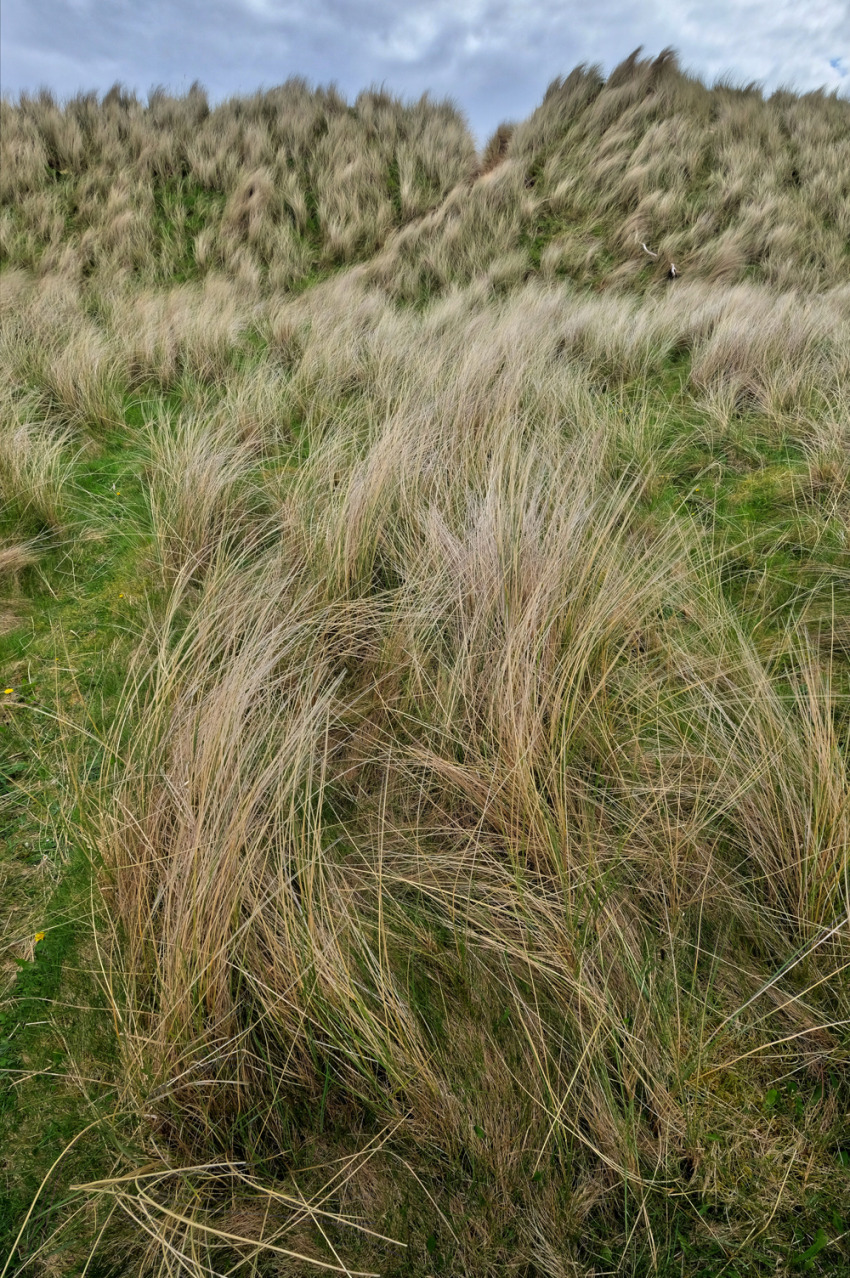 The sea breeze was strong along the tops of the dunes, but calm down in the deep sandy hollows.
The sea breeze was strong along the tops of the dunes, but calm down in the deep sandy hollows.
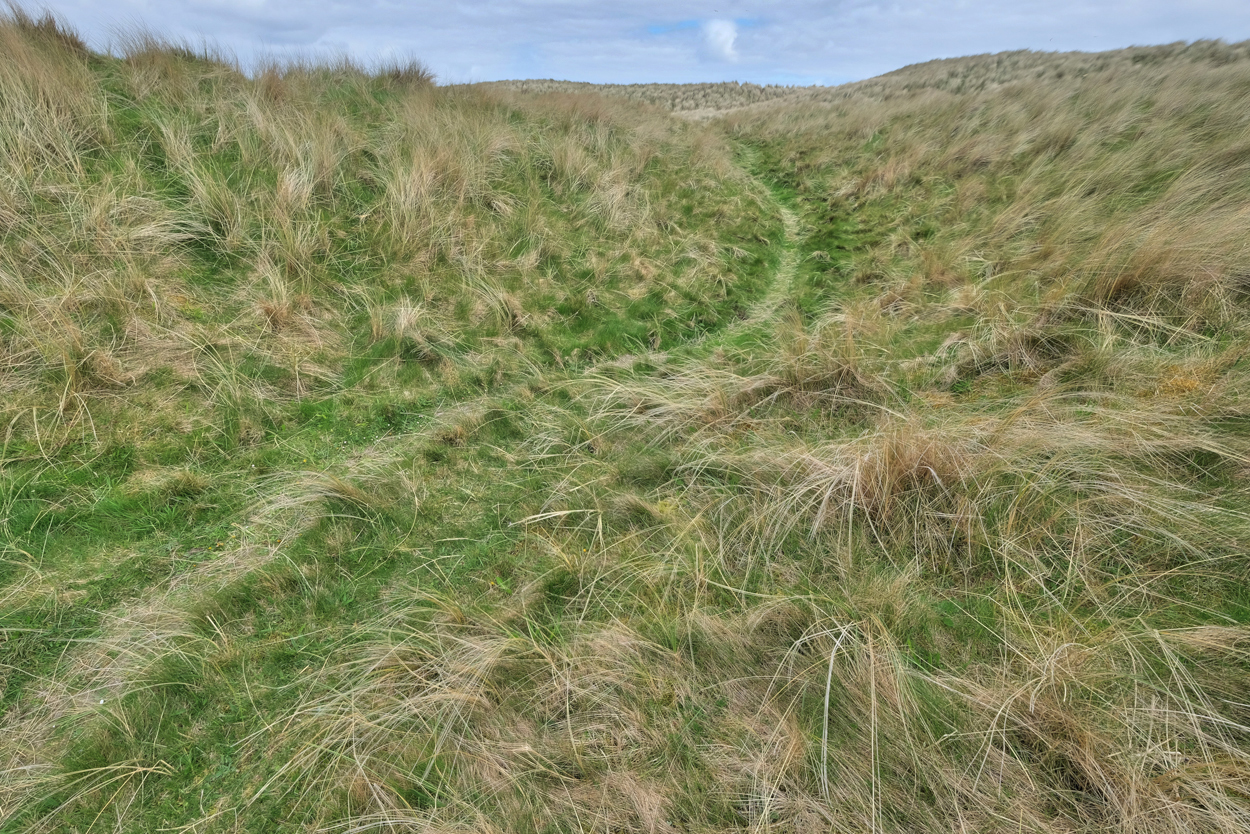 Walking the dune trails had a mystical quality to me . . .
Walking the dune trails had a mystical quality to me . . .
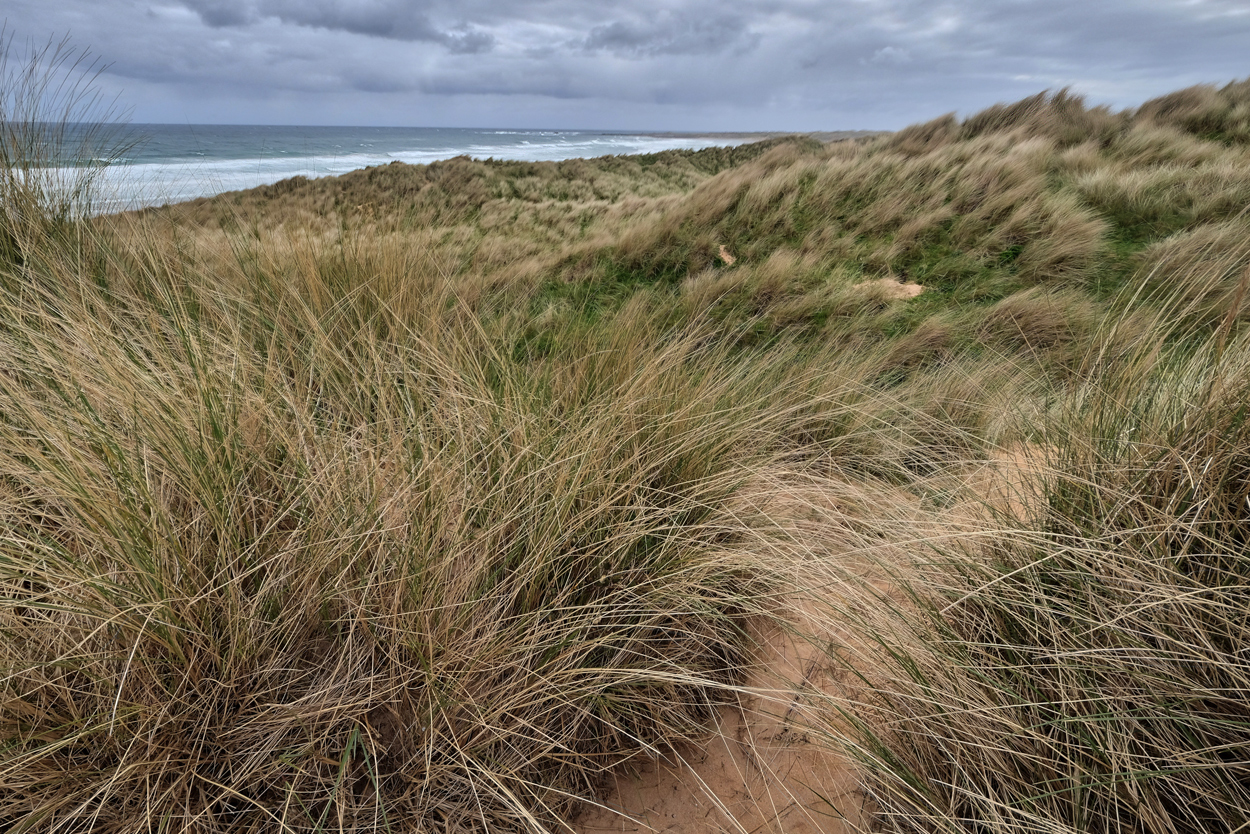 I crested a dune to find the North Sea . . . and miles of beach.
I crested a dune to find the North Sea . . . and miles of beach.
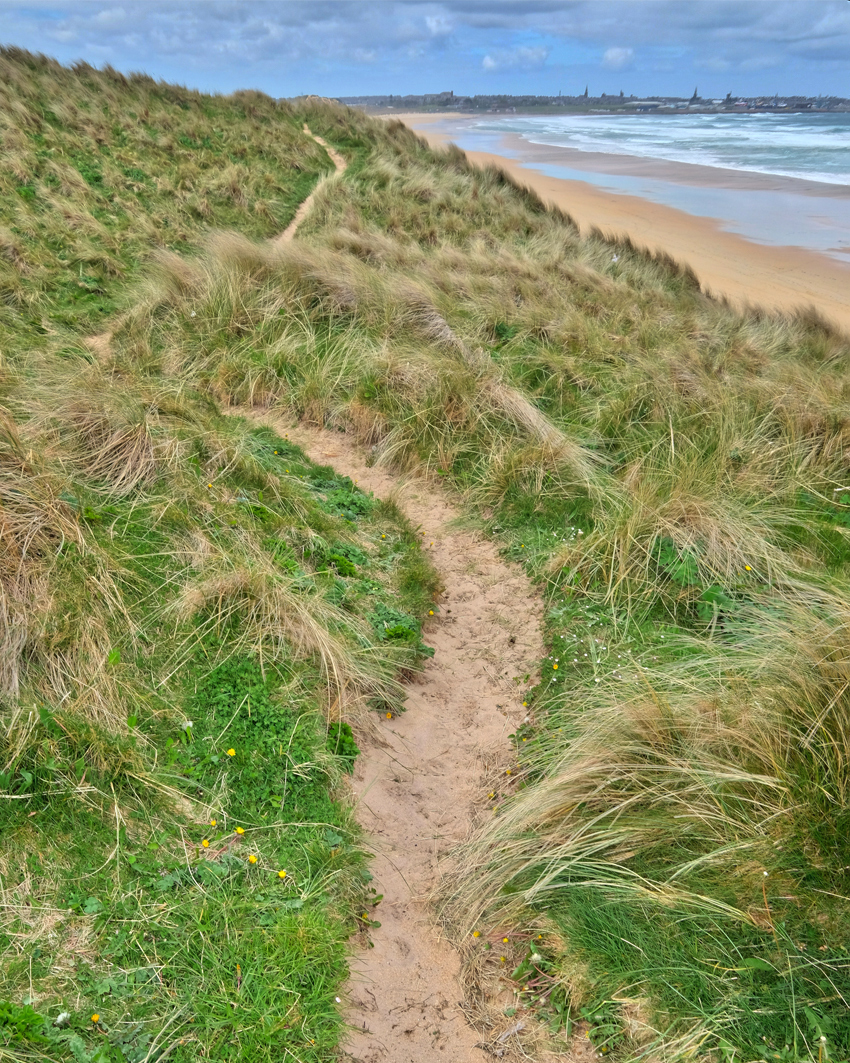 I looked left to the town of Fraserburgh, trying to decide which way to go . . .
I looked left to the town of Fraserburgh, trying to decide which way to go . . .
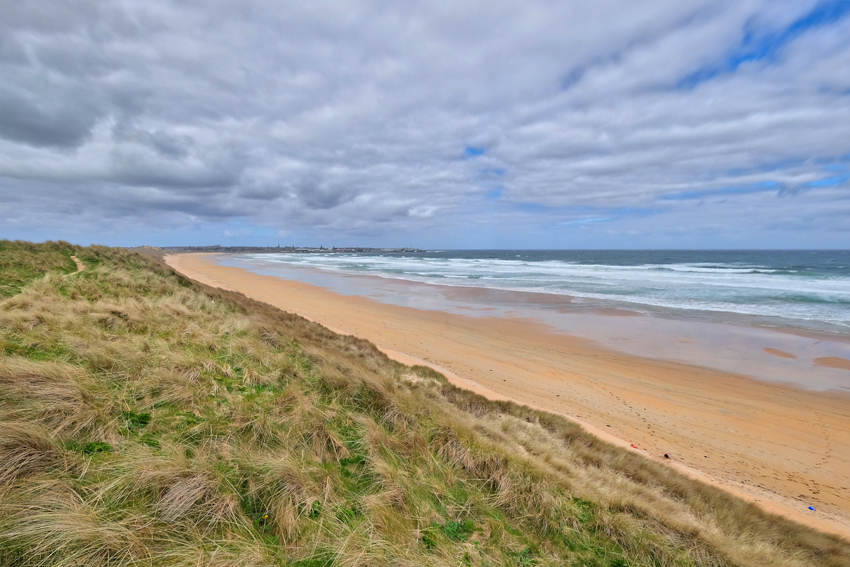 Although walking east toward Fraserburgh looked inviting . . .
Although walking east toward Fraserburgh looked inviting . . .
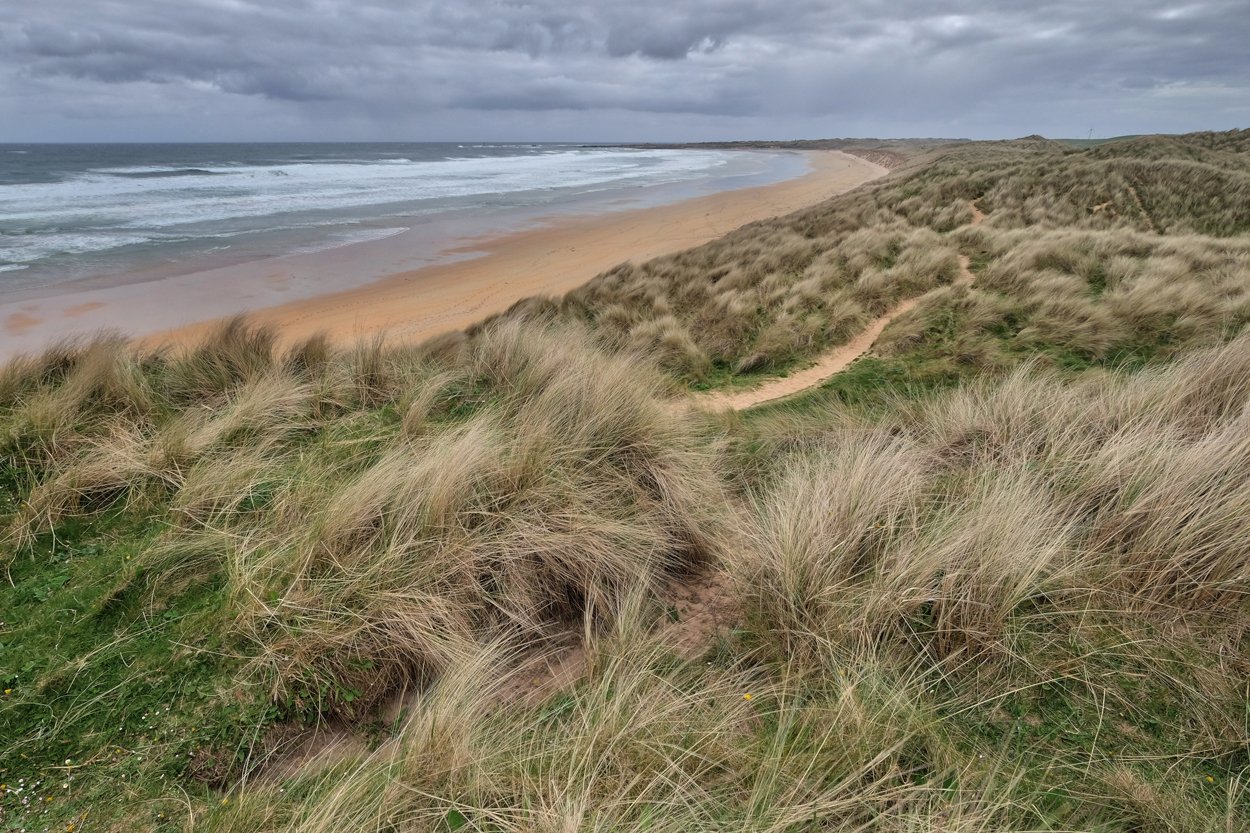 I decided to walk west toward the next village, Inverallochy, and what looked like a ship wreck. I wandered around in the web of sandy trails looking for a way down the embankments to the broad beach.
I decided to walk west toward the next village, Inverallochy, and what looked like a ship wreck. I wandered around in the web of sandy trails looking for a way down the embankments to the broad beach.
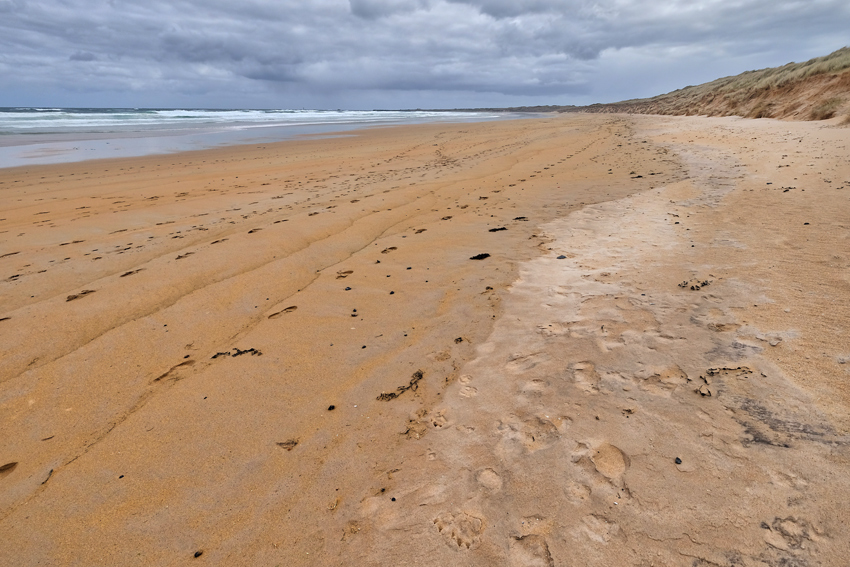 There were beachcombers on the broad Fraserburgh beach.
There were beachcombers on the broad Fraserburgh beach.
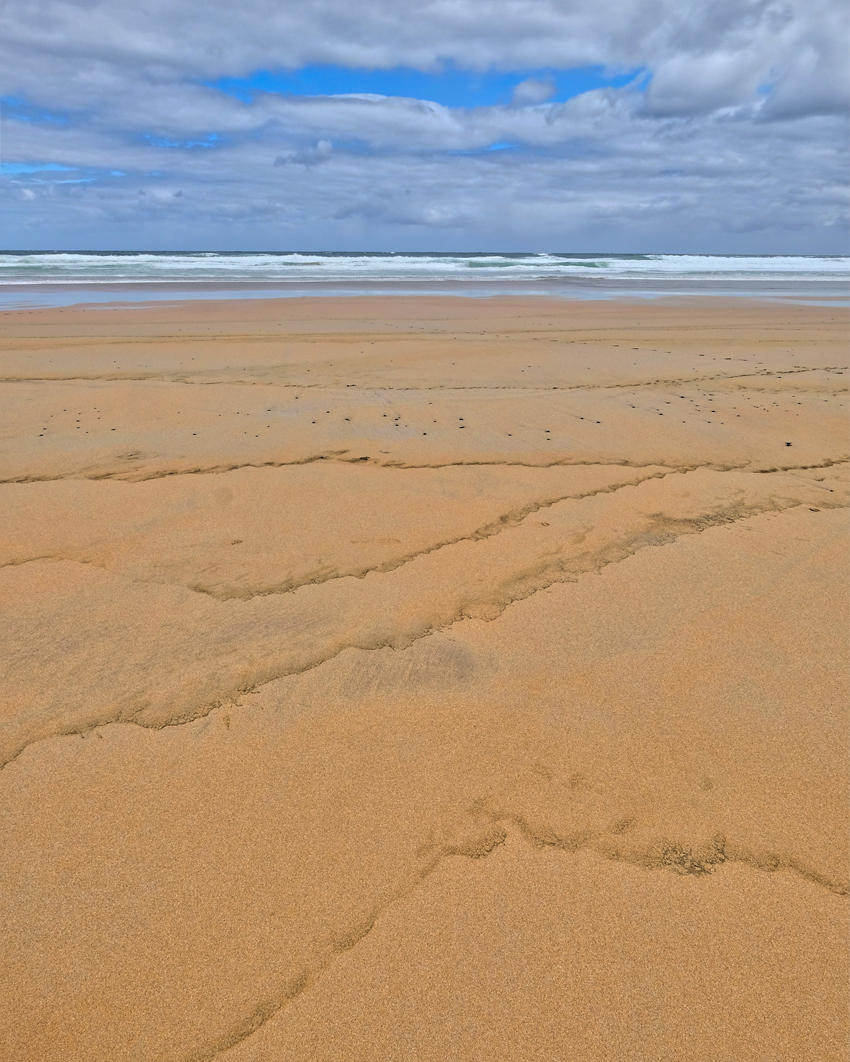 Fascinating patterns in the sand to look at.
Fascinating patterns in the sand to look at.
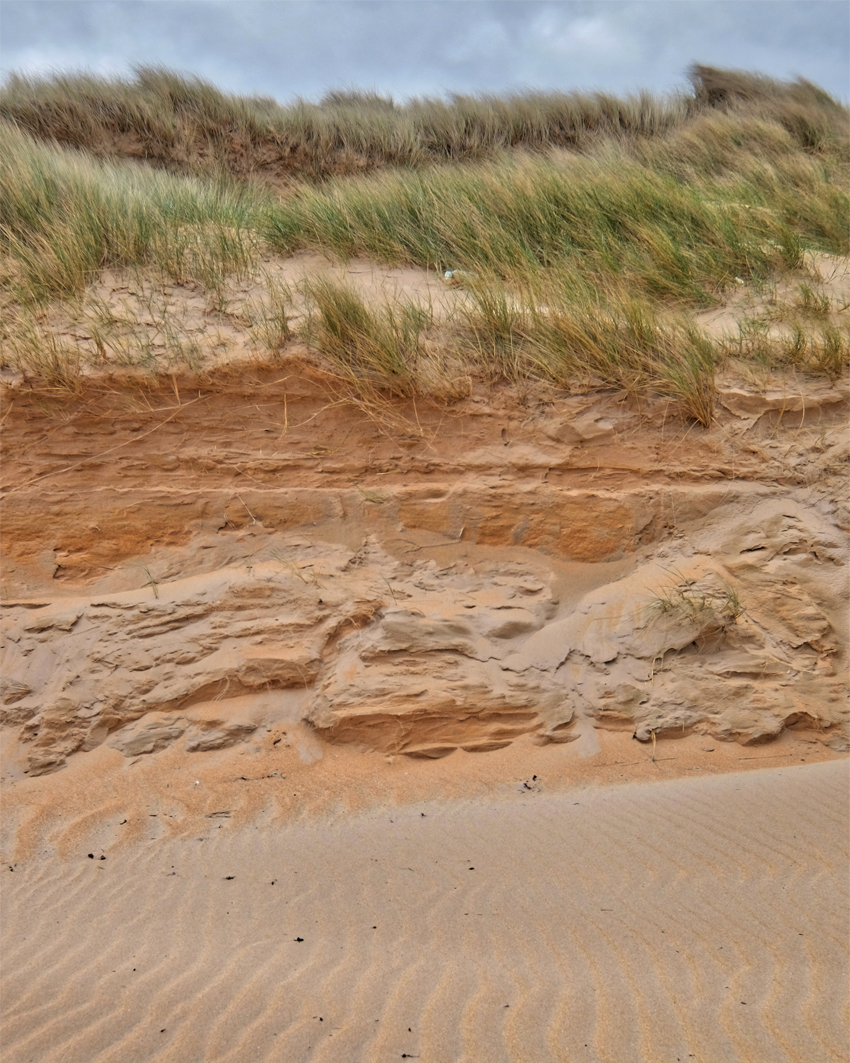 As sea level rises, the beach dunes are eroded.
As sea level rises, the beach dunes are eroded.
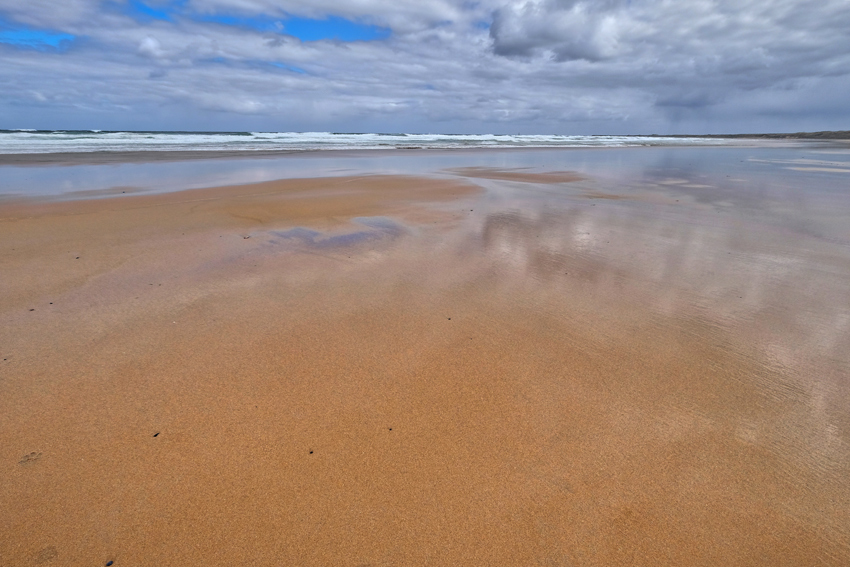 Beach, sea, sky . . . looking like a tropical paradise, but at 5c, not exactly tropical.
Beach, sea, sky . . . looking like a tropical paradise, but at 5c, not exactly tropical.
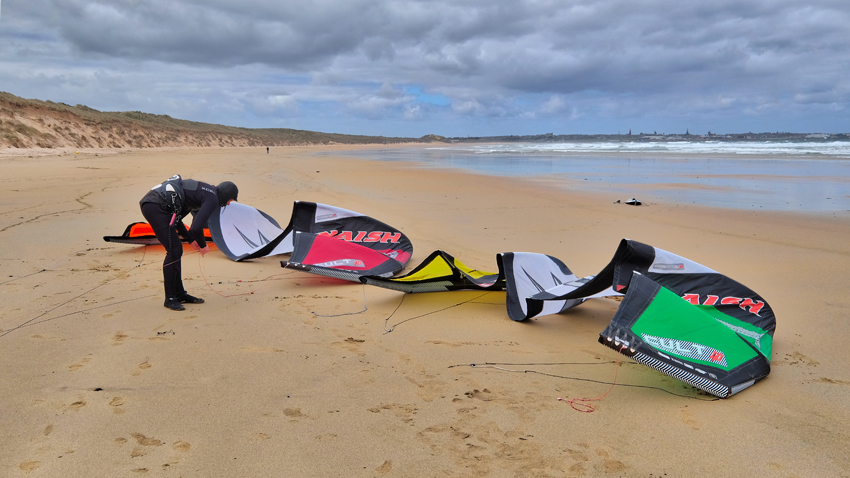 I wasn't the o nly person out on such a fine and windy day . . . these brave wind surfers were preparing for their brand of fun. I must add; the wind was very cold.
I wasn't the o nly person out on such a fine and windy day . . . these brave wind surfers were preparing for their brand of fun. I must add; the wind was very cold.
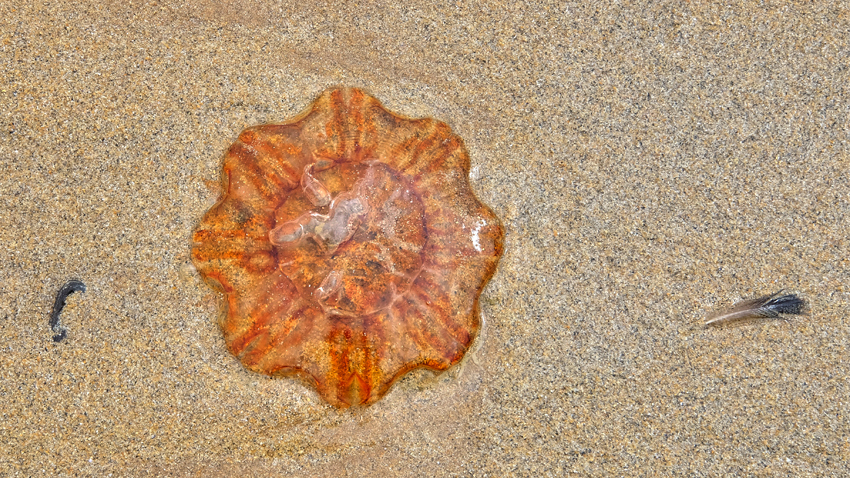 Jellyfish and feather.
Jellyfish and feather.
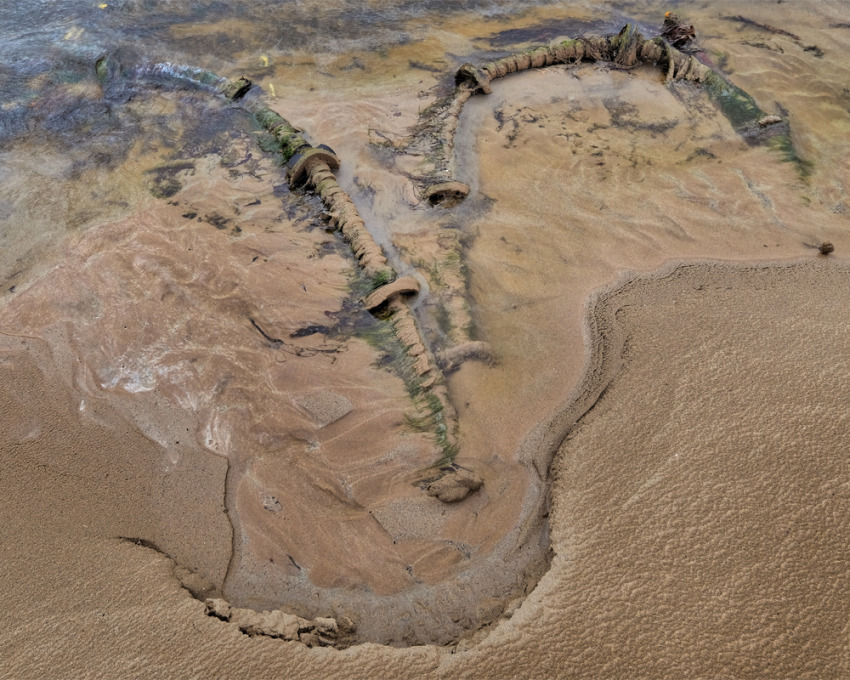 A beach combing find from somewhere far off in the North Sea.
A beach combing find from somewhere far off in the North Sea.
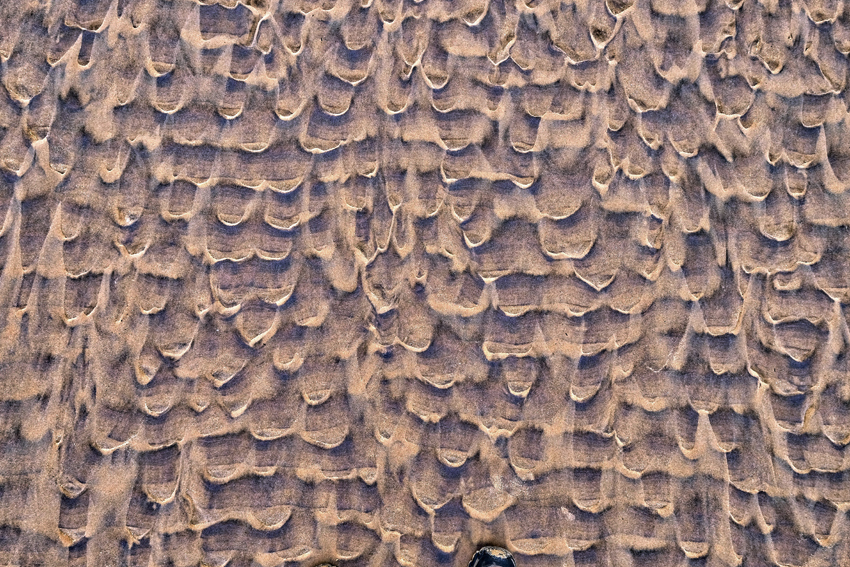 Such a broad beach creates wonderful patterns as the tide recedes.
Such a broad beach creates wonderful patterns as the tide recedes.
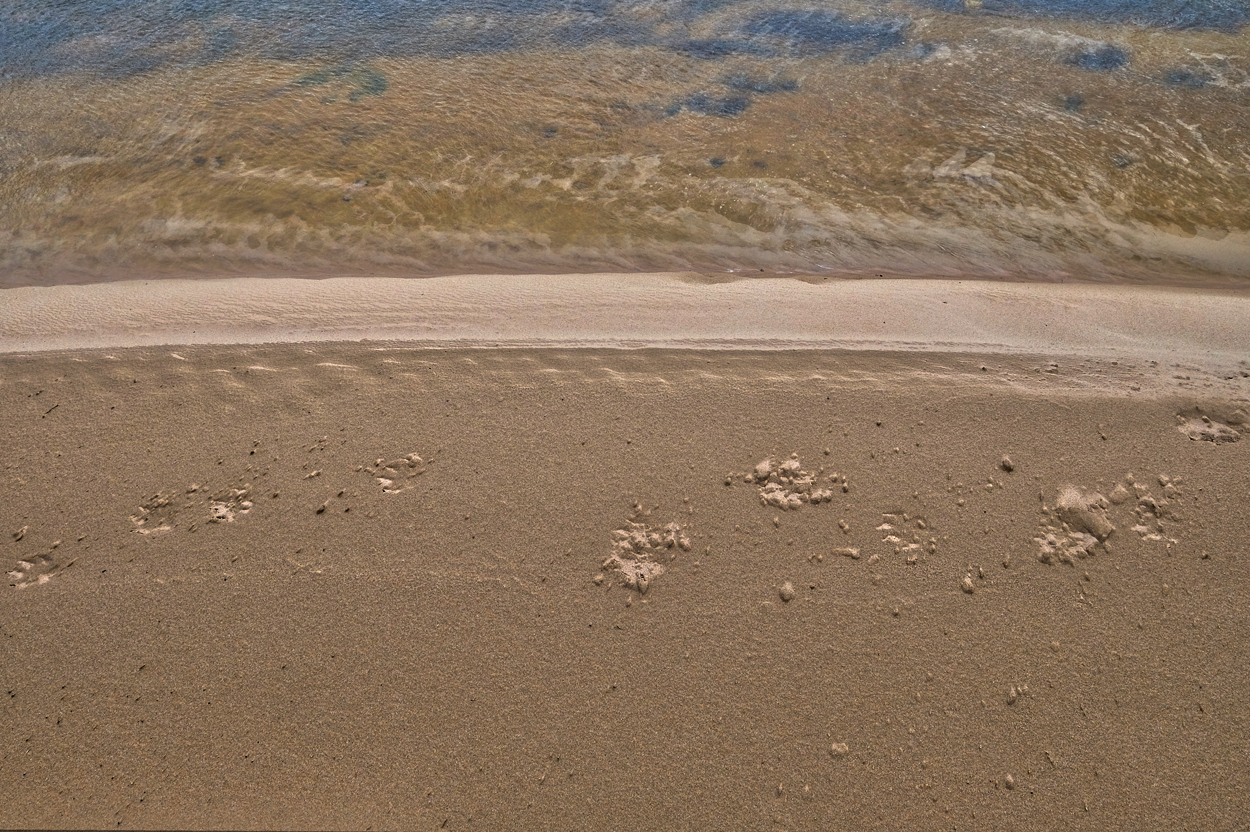 Where the beach met a fast moving burn, a set of contrasting shapes, textures, and colors met in a happy collision.
Where the beach met a fast moving burn, a set of contrasting shapes, textures, and colors met in a happy collision.
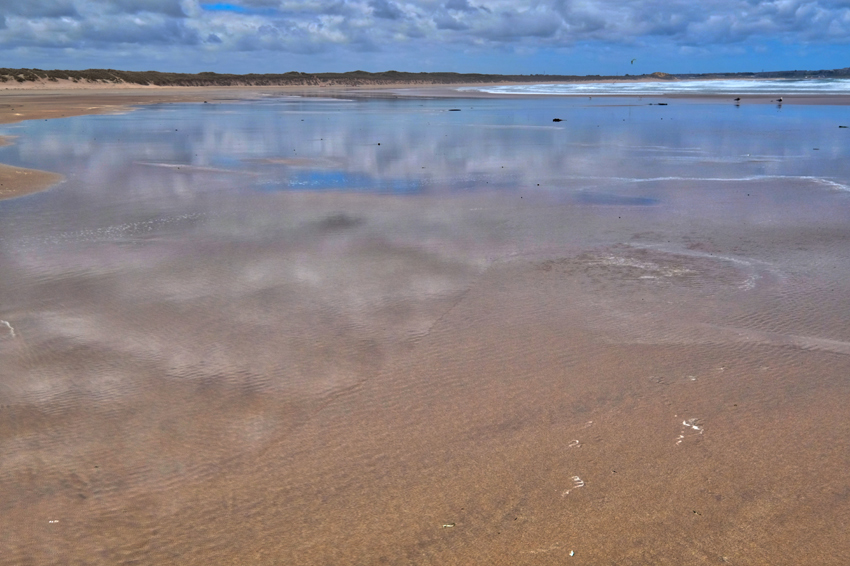 I walked all the way to the end of the beach . . .
I walked all the way to the end of the beach . . .
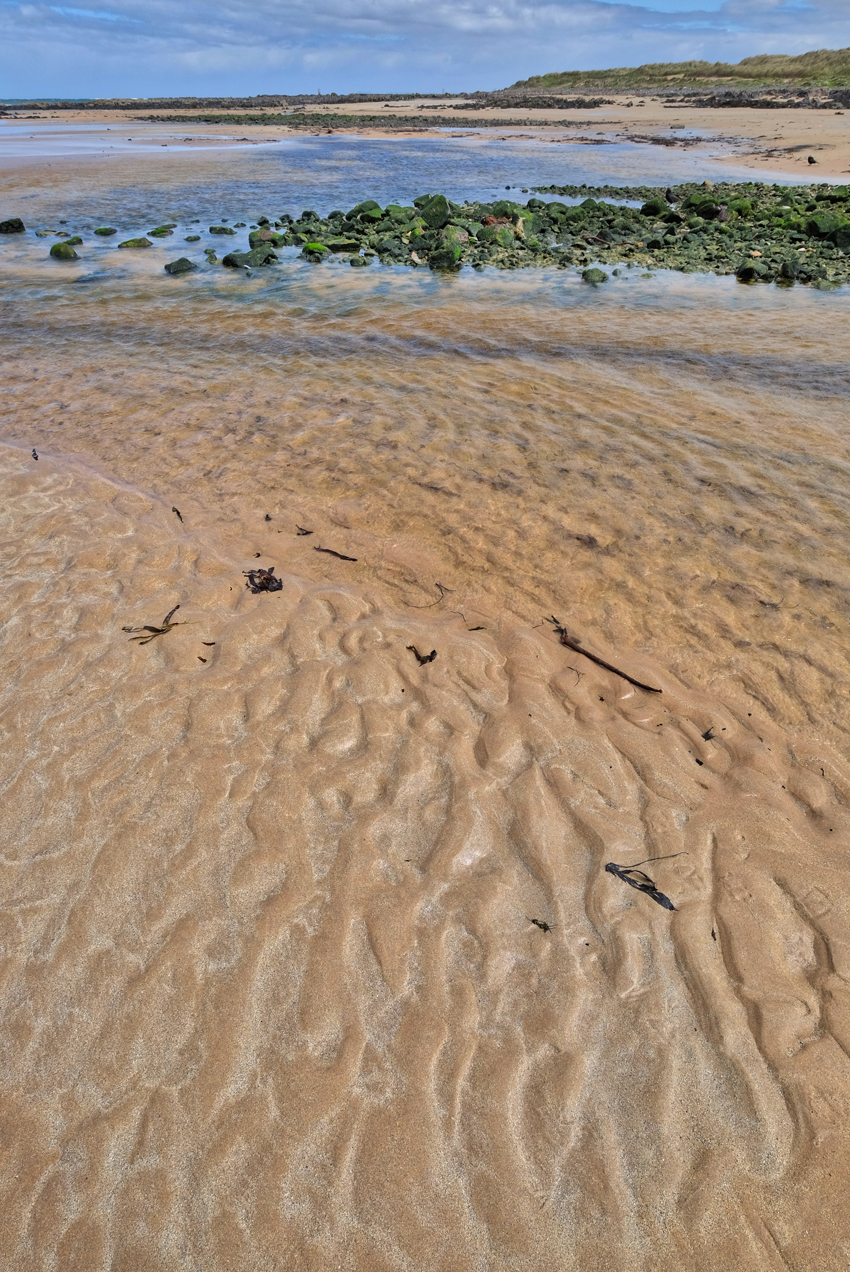 I arrived at the estuary of the Waters of Philorth, but could not find a way across the swift and deep waters without getting my feet wet.
I arrived at the estuary of the Waters of Philorth, but could not find a way across the swift and deep waters without getting my feet wet.
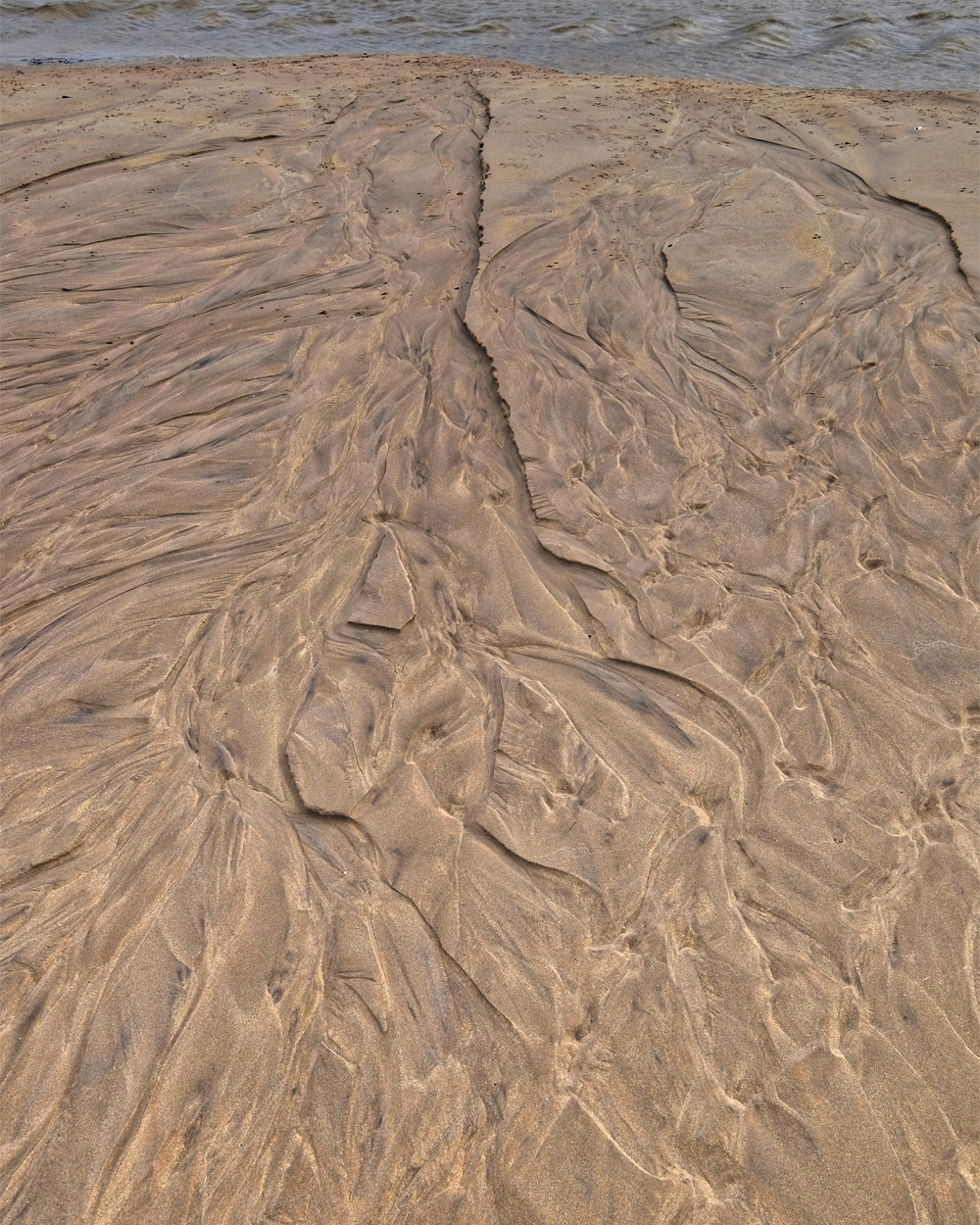 The last big wave drained into the burn this way.
The last big wave drained into the burn this way.
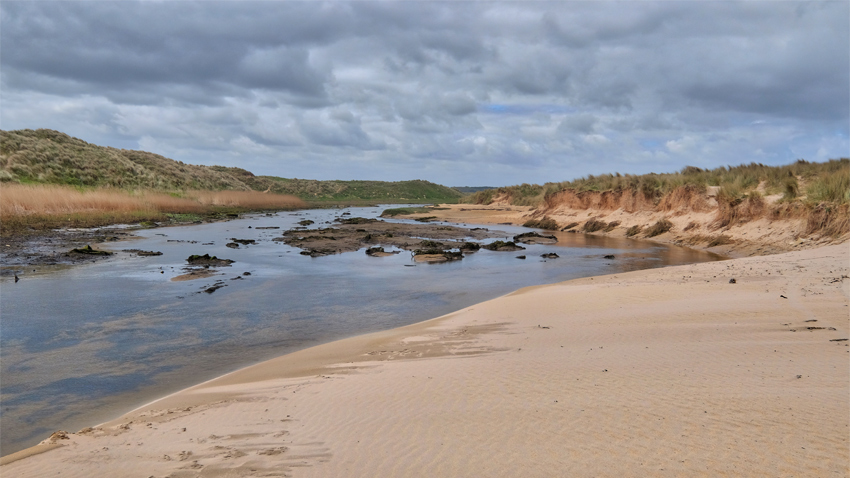 I didn't want to go back the way I came, so I walked inland along the stream knowing I would eventually run into the road.
I didn't want to go back the way I came, so I walked inland along the stream knowing I would eventually run into the road.
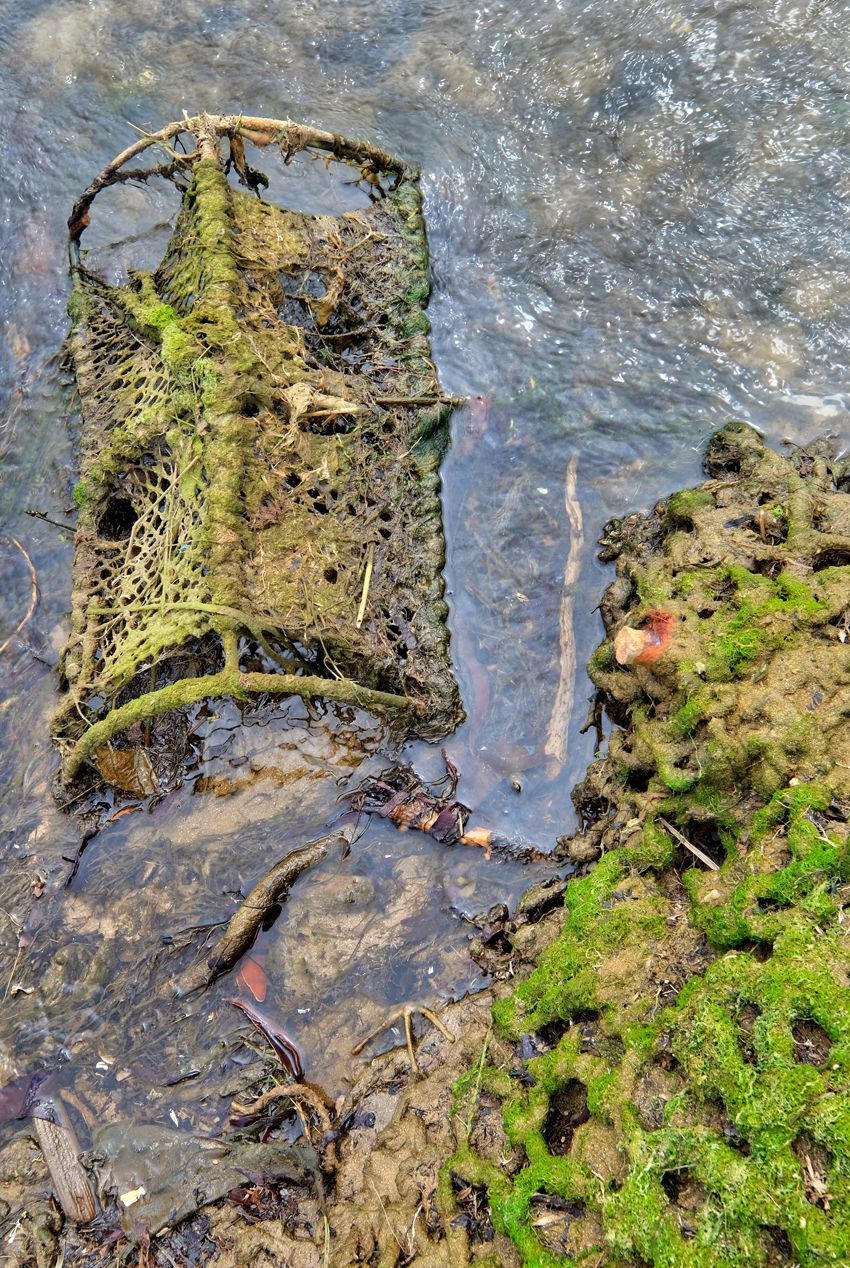 I could not find a way across the burn, The Waters of Philorth, so I followed it inland, stopping here and there to study scenes of beauty.
I could not find a way across the burn, The Waters of Philorth, so I followed it inland, stopping here and there to study scenes of beauty.
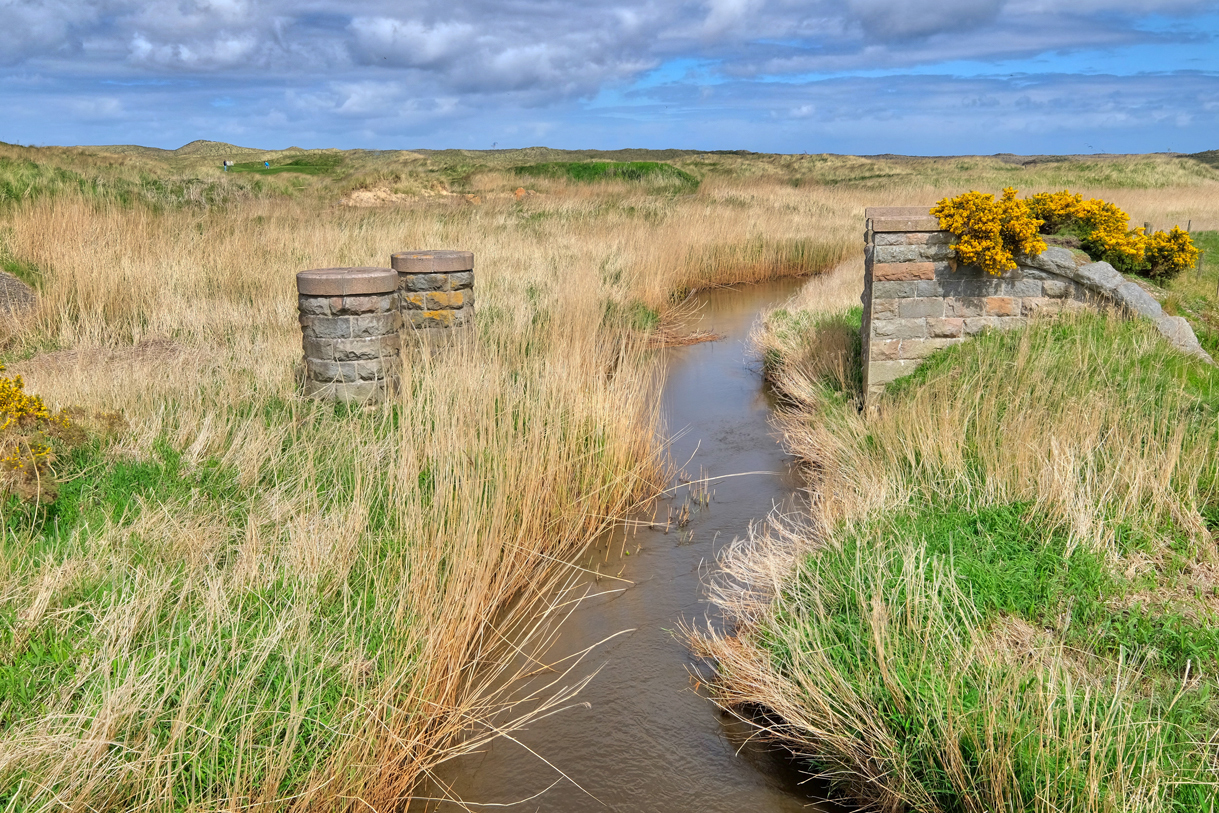 The Waters of Philorth eventually came to the highway and this old disassembled rail bridge.
The Waters of Philorth eventually came to the highway and this old disassembled rail bridge.
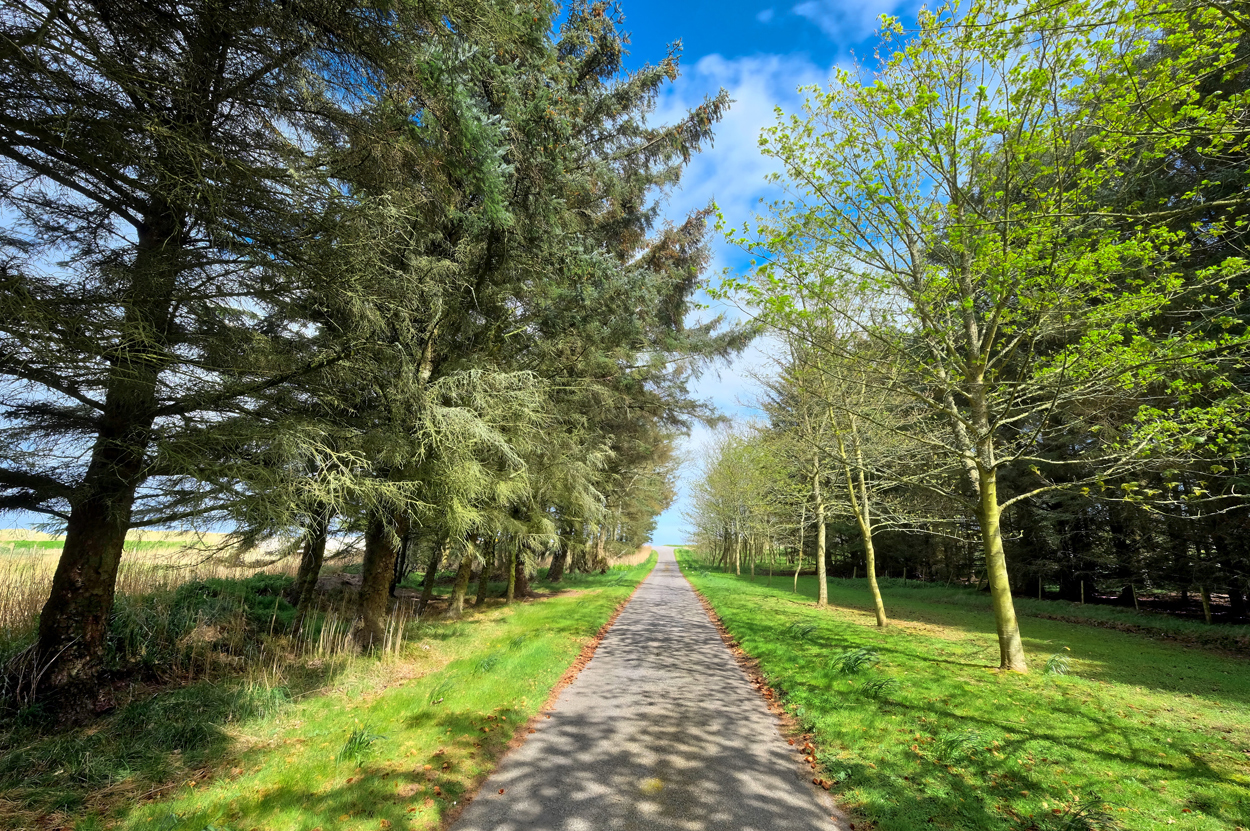 This inviting road stood in front of me, so I walked in until . . .
This inviting road stood in front of me, so I walked in until . . .
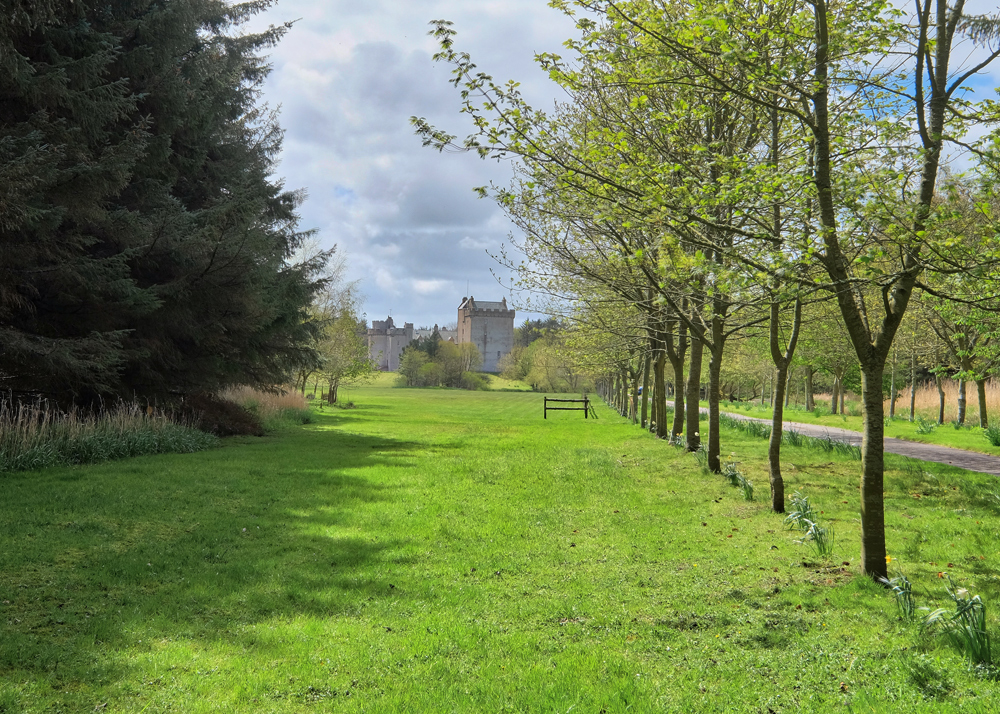 I walked up the road, which turned out to be the driveway of Castle Cairnbulg . . . and a 'Private Property' sign. Yes, this is not only a real castle, but it has been continuously occupied by the original Fraser family since 1308. Currently. Katharine Fraser, Mistress of Salton, resides within the 700 year old walls.
I walked up the road, which turned out to be the driveway of Castle Cairnbulg . . . and a 'Private Property' sign. Yes, this is not only a real castle, but it has been continuously occupied by the original Fraser family since 1308. Currently. Katharine Fraser, Mistress of Salton, resides within the 700 year old walls.
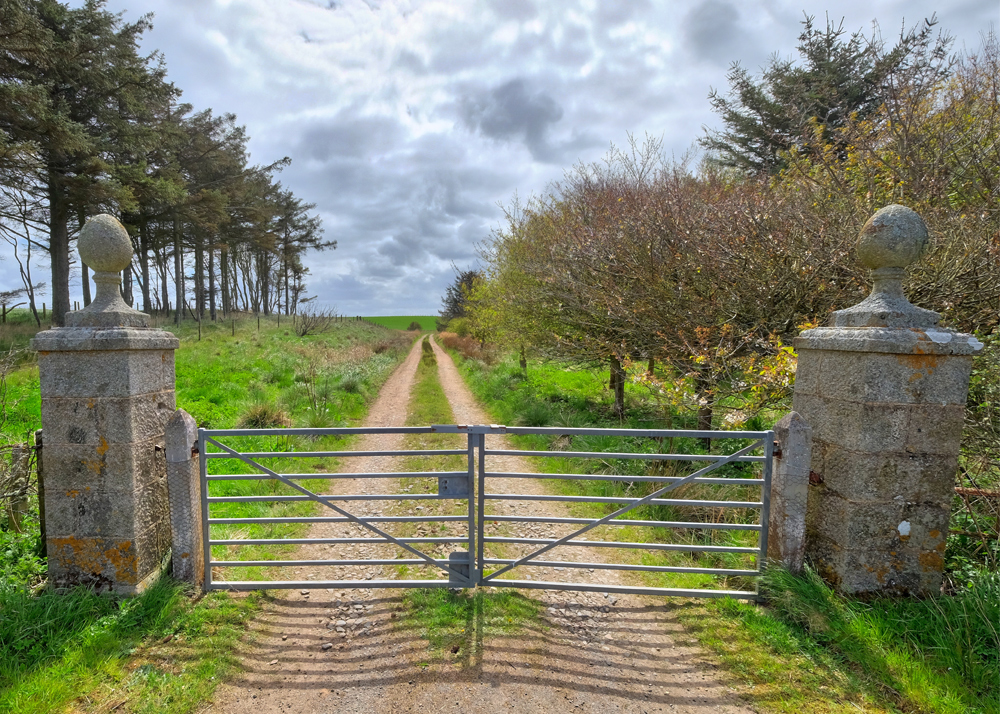 I considered jumping the estate gates and exploring the park-like grounds of the castle . . . but didn't.
I considered jumping the estate gates and exploring the park-like grounds of the castle . . . but didn't.
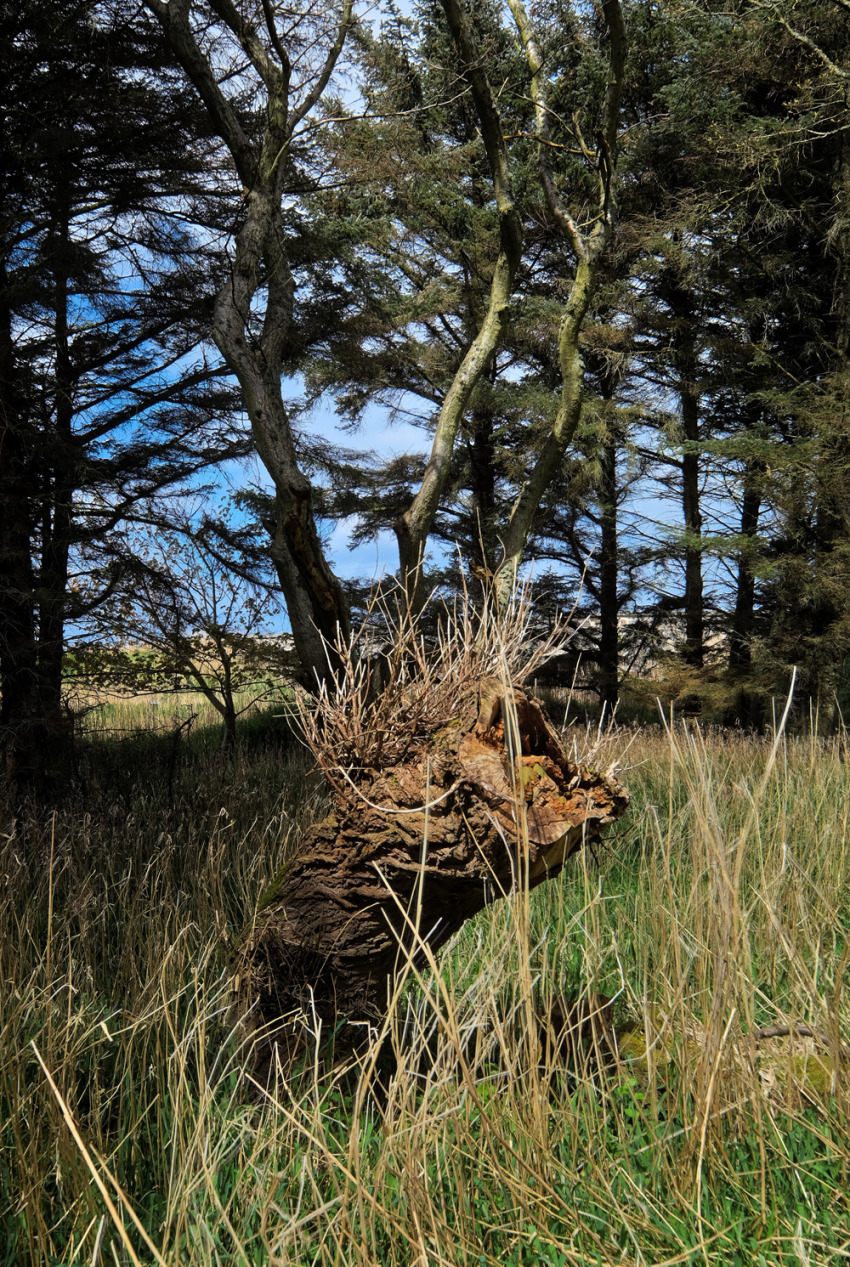 I took a shortcut though a small wood and found this striking stump.
I took a shortcut though a small wood and found this striking stump.
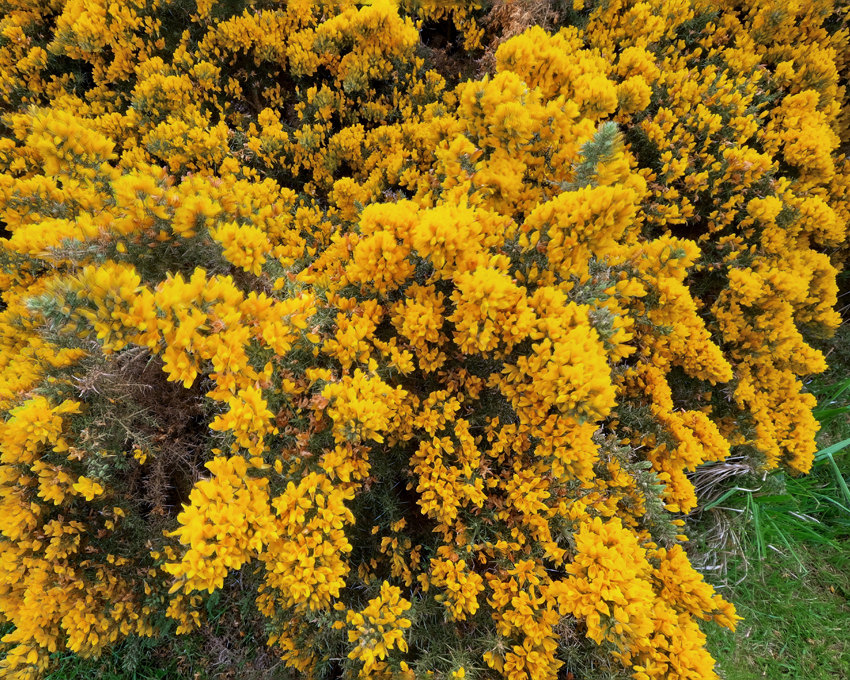 The gorse (ulex europaeus) was in full bloom.
The gorse (ulex europaeus) was in full bloom.
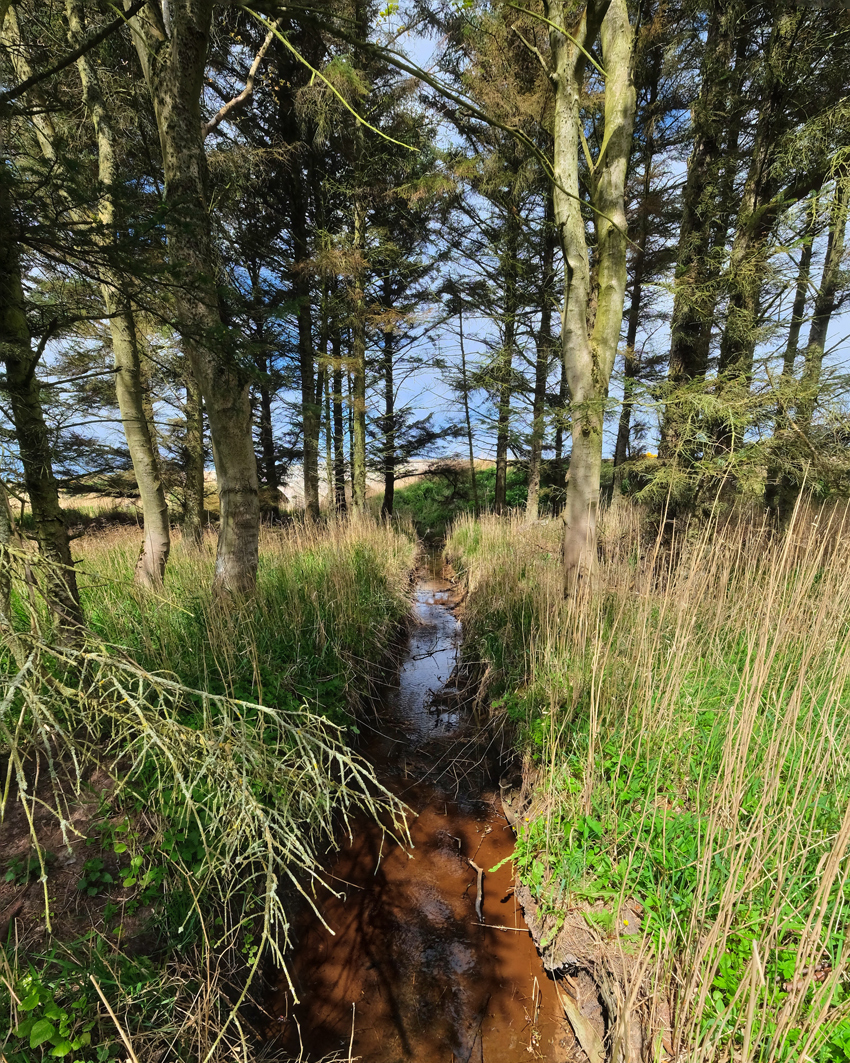 Boggy land draining.
Boggy land draining.
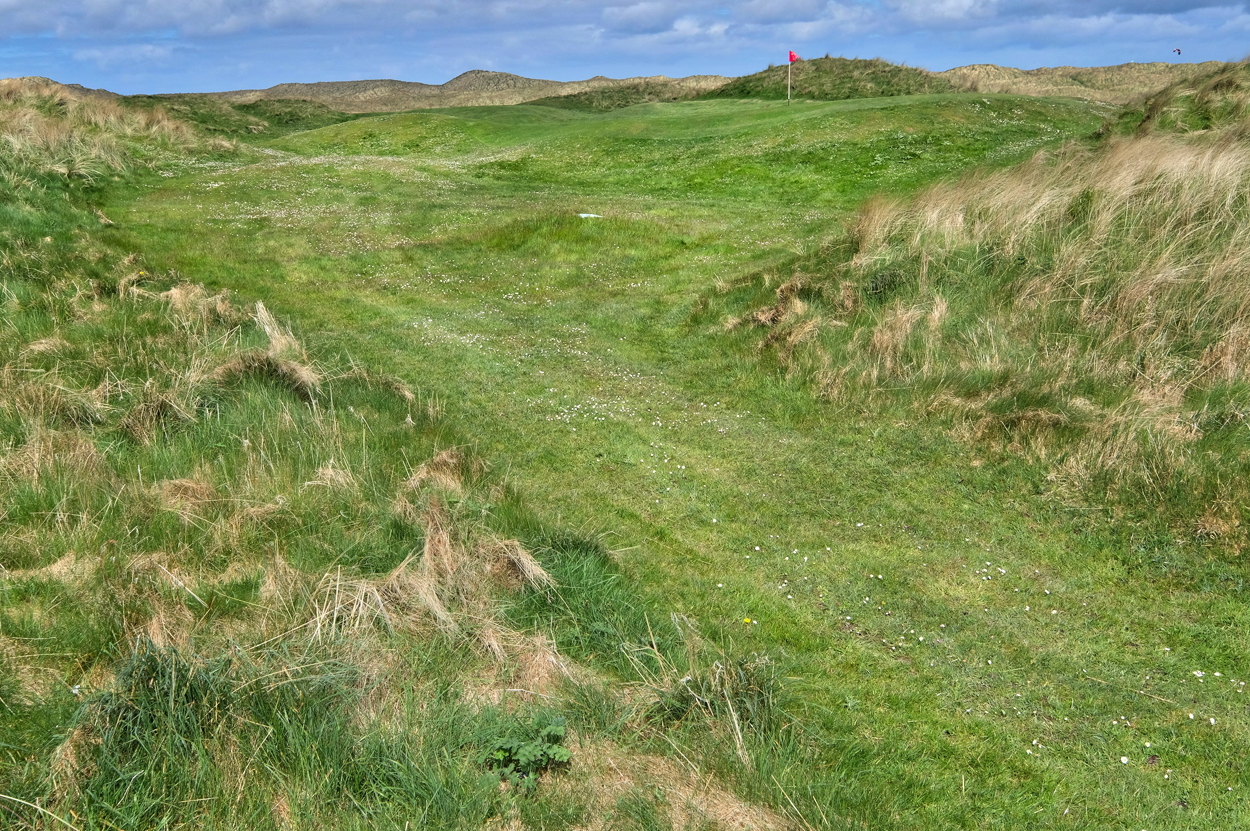 Of course, this trip was about my wife playing in a golf tournament. I walked back through the historic golf course to the Fraserburgh Golf Club, the 7th oldest golf course in the world. Although the golf club was officially established in 1777, golf has been recorded being played here since 1618 . . . 398 years!
Of course, this trip was about my wife playing in a golf tournament. I walked back through the historic golf course to the Fraserburgh Golf Club, the 7th oldest golf course in the world. Although the golf club was officially established in 1777, golf has been recorded being played here since 1618 . . . 398 years!
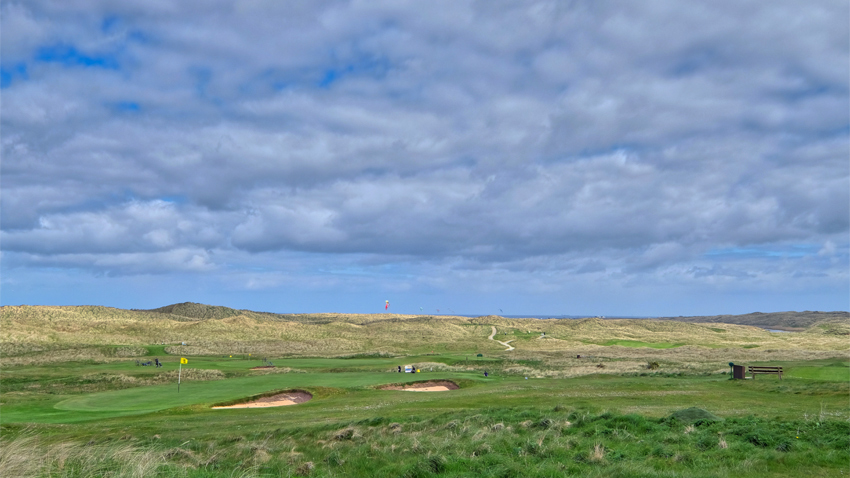 It is a beautiful course in a beautiful setting. It had been a fine day . . . with a five-mile walk.
It is a beautiful course in a beautiful setting. It had been a fine day . . . with a five-mile walk.
Scotland - A Forest Walk: Barkscapes
 Sunday, May 8, 2016 at 11:13PM
Sunday, May 8, 2016 at 11:13PM  With my wonderful wife playing a round of golf at a nearby course, I was free to ramble in the forest.
With my wonderful wife playing a round of golf at a nearby course, I was free to ramble in the forest.
 There were different kinds of woods.
There were different kinds of woods.
 The trail was good, and well-maintained. But each kind of forest had one thing in common . . . incredibly interesting and beautiful bark! Barkscapes.
The trail was good, and well-maintained. But each kind of forest had one thing in common . . . incredibly interesting and beautiful bark! Barkscapes.
 I spent Saturday morning walking in the Haughton County Park outside of Alford, Scotland. There was much to see.
I spent Saturday morning walking in the Haughton County Park outside of Alford, Scotland. There was much to see.
 Haughton County Park encompasses a variety of landscapes, including a motorhome park, a stately mansion, and some wild forest land.
Haughton County Park encompasses a variety of landscapes, including a motorhome park, a stately mansion, and some wild forest land.
 I wasn't the first person to visit these woods. In fact, in the summer, when the campground and RV park fills up, I bet these woods are crawling with visitors . . . I don't mind. I'm glad with the thought people are out of their homes . . . and not in front of their television sets.
I wasn't the first person to visit these woods. In fact, in the summer, when the campground and RV park fills up, I bet these woods are crawling with visitors . . . I don't mind. I'm glad with the thought people are out of their homes . . . and not in front of their television sets.
 There are often very strong storms in Scotland with fierce winds. There is a history of these storms in the blown down trees that litter the forest floor.
There are often very strong storms in Scotland with fierce winds. There is a history of these storms in the blown down trees that litter the forest floor.
 Some of the fallen trees have been down for a long time and show the action of time and weather.
Some of the fallen trees have been down for a long time and show the action of time and weather.
 The great winds have literally ripped some of the trees apart.
The great winds have literally ripped some of the trees apart.
 Broken, ripped, dried, and weathered.
Broken, ripped, dried, and weathered.
 Otherworldly landscapes in old wood.
Otherworldly landscapes in old wood.
 Dreams in wood and bark.
Dreams in wood and bark.
 A few of the fallen trees had been cut, revealing rings, patterns of color, and clefts.
A few of the fallen trees had been cut, revealing rings, patterns of color, and clefts.
 Grounded stumps.
Grounded stumps.
 A history of slow healing.
A history of slow healing.
 Torn and cut.
Torn and cut.
 Nature's Art.
Nature's Art.
 Some trees had been on the forest floor for a very long time and were in a state of advanced decomposition.
Some trees had been on the forest floor for a very long time and were in a state of advanced decomposition.
 The old and dead nurturing the new and living.
The old and dead nurturing the new and living.
 The living trees in this wood had their own strange beauty.
The living trees in this wood had their own strange beauty.
 As is often the case, family members of the old estates traveled throughout the British Empire and brought back exotic trees and seeds.
As is often the case, family members of the old estates traveled throughout the British Empire and brought back exotic trees and seeds.
 Exposed to the sun over the winter months, the trees take on a green-tinged coating of light moss.
Exposed to the sun over the winter months, the trees take on a green-tinged coating of light moss.
 I had to remember that these trees were alive, in several senses of the word. They were forming: changing, developing, and reacting.
I had to remember that these trees were alive, in several senses of the word. They were forming: changing, developing, and reacting.
 A story left behind in scars . . . like people.
A story left behind in scars . . . like people.
 There was a mix of pines.
There was a mix of pines.
 Pine bark, with its shattered, ever-expanding surfaces.
Pine bark, with its shattered, ever-expanding surfaces.
 Another kind of pine/evergreen with a dusting of lichen.
Another kind of pine/evergreen with a dusting of lichen.
 Deep within the deep and dark forest . . . .
Deep within the deep and dark forest . . . .
 Late Winter, early Spring growth pushing the old bark away.
Late Winter, early Spring growth pushing the old bark away.
 The work of woodsmen here and there.
The work of woodsmen here and there.
 Swirling, ripped, and torn beauty.
Swirling, ripped, and torn beauty.
 A Winter forest just waking up to Spring.
A Winter forest just waking up to Spring.
 There have only been a few days of sunshine and "warm" weather since October, but the ferns were beginning to unfurl.
There have only been a few days of sunshine and "warm" weather since October, but the ferns were beginning to unfurl.
 I was surprised, and mystified upon discovering this structure in the deep forest.
I was surprised, and mystified upon discovering this structure in the deep forest.
 For the life of me I couldn't figure out what in the world it could be!
For the life of me I couldn't figure out what in the world it could be!
 This open area in the forest was on the other side of the wooden structure . . .
This open area in the forest was on the other side of the wooden structure . . .
 Ah! The Vale of Alford Curling Club forest curling pond . . . . now empty after the winter season. What a surprise to see!
Ah! The Vale of Alford Curling Club forest curling pond . . . . now empty after the winter season. What a surprise to see!
 There were strategically placed benches in the wood. I sat next to this interesting stone, the only stone I saw in the forest. Little did I know just how interesting it was. It was a named stone: The Gordon Stane.
There were strategically placed benches in the wood. I sat next to this interesting stone, the only stone I saw in the forest. Little did I know just how interesting it was. It was a named stone: The Gordon Stane.
 George Gordon, Lord of the Gordon Clan was laid out here after perishing is the Battle of Alford on July 2, 1645. It seems the forest I was walking through had been a battlefield 371 years ago.
George Gordon, Lord of the Gordon Clan was laid out here after perishing is the Battle of Alford on July 2, 1645. It seems the forest I was walking through had been a battlefield 371 years ago.
 I walked through the boggy forest for many hours.
I walked through the boggy forest for many hours.
 Such a beautiful place
Such a beautiful place
 I walked out of the forest and into the parkland that surrounds the mansion.
I walked out of the forest and into the parkland that surrounds the mansion.
 A line of exotic evergreens marked the drive to the mansion.
A line of exotic evergreens marked the drive to the mansion.
 Haughton House mansion, a listed property,not part of the county park, and the offices of a very large RV and camping facility.
Haughton House mansion, a listed property,not part of the county park, and the offices of a very large RV and camping facility.
 The daffodils were everywhere.
The daffodils were everywhere.
 It felt like Spring . . . at last!
It felt like Spring . . . at last!
 Thank you Aberdeenshire for keeping such a wonderful park in such good shape.
Thank you Aberdeenshire for keeping such a wonderful park in such good shape.
 I walked the mile back into the village of Alford and into the Grampian Transport Museum, where I work as a volunteer. It was another great day in Scotland.
I walked the mile back into the village of Alford and into the Grampian Transport Museum, where I work as a volunteer. It was another great day in Scotland.
